Abstract
The efficient Pd-catalyzed Heck reaction of diverse tertiary alkyl halides with alkenes has been developed. Unactivated tertiary alkyl halides efficiently react at room temperature under visible light irradiation with no exogenous photosensitizers required. For activated tertiary alkyl halides, the same catalytic system works well without light. These methods offer a general access to electronically diverse alkenes possessing quaternary and functionalized tertiary allylic carbon centers. The substituents at these centers include alkyl-, carbalkoxy-, tosyl-, phosphonyl-, and boronate groups. It was also shown that the end-game mechanism of this transformation may vary depending on the type of the substrates used.
Graphical Abstract
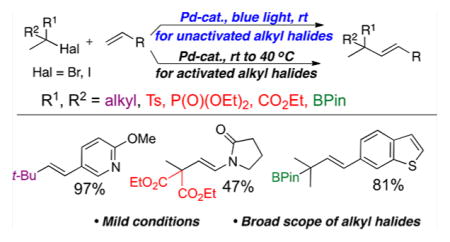
The Mizoroki–Heck reaction1 is a fundamental transformation in organic chemistry that is traditionally used for coupling of aryl and vinyl halides/pseudohalides with alkenes.2 Originally, employment of alkyl halides in this reaction was not straightforward due to premature β-hydrogen elimination3 and slow oxidative addition rates.4 Although there were numerous reports on the Heck reaction of activated5 and perfluorinated6 alkyl halides, employment of unactivated alkyl halides became possible only after seminal works by Fu7 and Alexanian.8 Due to the above-mentioned reasons, employment of tertiary alkyl halides in Heck reactions is even more problematic. For activated tertiary alkyl halides, the solution was found by Lei,9 Thomas,10 and Nishikata11 employing Ni-, Fe-, and Cu catalysts, respectively (Scheme 1a). Still, these methods either require high temperatures or are limited in scope. All these transformations were proposed to occur via generation of alkyl radical species stabilized by adjacent electron-withdrawing groups. This may be a reason for the underutilization of unactivated tertiary alkyl halides in Heck-type reactions for a long time. In 2002, Oshima reported the Co-catalyzed Heck-type coupling of 1°, 2°, and 3° alkyl halides with styrenes promoted by Me3SiCH2MgCl (Scheme 1b). Obviously, the requisite Grignard reagent limits the scope of this method.12 Recently, Hashmi reported a single example of coupling between tert-butyl bromide and 1,1-diphenyl ethene under light-induced, Au-catalyzed Heck-type reaction (Scheme 1c).13a A single report by deMeijere disclosed a moderately efficient Pd-catalyzed Heck reaction of unactivated tertiary halides (Scheme 1d).14 However, it is limited to employment of adamantyl bromide, a substrate not disposed to β-hydrogen elimination.
Scheme 1.

Heck Reaction of Tertiary Alkyl Halides
Evidently, the development of a method that would feature mild reaction conditions and broad substrate scope, including both activated and unactivated tertiary alkyl halides, is highly warranted. Very recently, our group introduced the first visible light-induced15 Pd-catalyzed Heck reaction, which allows activated and unactivated primary and secondary alkyl electrophiles to react with vinylarenes in a highly efficient and stereoselective manner (Scheme 1e).16 Herein, we report general room temperature, visible light-induced,17 exogenous photosensitizer-free18 Pd-catalyzed Heck reaction of a wide range of tertiary alkyl halides with alkenes to produce electronically neutral,19 electrophilic, and nucleophilic allylic systems possessing quaternary and functionalized tertiary carbon center (Scheme 1f).
Aiming at the elaboration of the Heck reaction with unactivated tertiary alkyl halides, we commenced our studies with tert-butyl iodide 1a. First, the reaction of 1a with styrene 2a was tested under the reported palladium-based thermal conditions;8b,20 however, only decomposition of the starting materials was observed (Table 1, entries 1 and 2). Switching to our previously found conditions for visible-light-induced Heck reaction of primary and secondary alkyl halides16 led to formation of 3aa in 87% yield (entry 3)! Other catalyst/ligand combinations, such as Pd(PPh3)4, and Pd(OAc)2 with DPEphos, t-Bu-Xantphos, L, 18b,c or DPPE were much less efficient (entries 4–7). Control experiments indicated that both light and the Pd catalyst are essential for this transformation (entries 8 and 9). Naturally, we were eager to verify if this method could also be used for reactions of activated tertiary alkyl halides. It was found that activated tertiary alkyl halides of different electronic nature, such as 1d and 1h, were incompatible with the standard thermal palladium-based conditions, reported for alkyl Heck reaction8b (entries 10 and 13). However, under the developed blue light conditions, satisfactory yields of the corresponding products were obtained (entries 11 and 14). Further optimization under blue light led to significant improvement of the reaction efficiency for 1h (entry 13). Remarkably, the control experiments for both activated substrates (1d and 1h) indicated that these reactions proceed efficiently without light to produce 3da and 3ha at room temperature and at 40 °C, respectively (entries 12 and 16).
Table 1.
Optimizationa
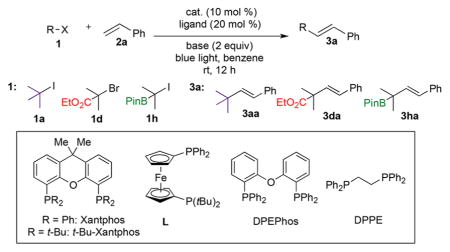
| ||||||
|---|---|---|---|---|---|---|
| no | 1 | cat. | ligand | base | deviation from standard conditions | Yield of 3ab (%) |
| 1 | 1a | Pd(PPh3)4 | - | Cs2CO3 | toluene, 50 °C | dec. |
| 2 | 1a | Pd(dppf)Cl2 | - | Cy2NMe | PhCF3, 110 °C | dec. |
| 3 | 1a | Pd(OAc)2 | Xantphos | Cs2CO3 | - | 87 |
| 4 | 1a | Pd(PPh3)4 | - | Cs2CO3 | THF | 14 |
| 5 | 1a | Pd(OAc)2 | DPEPhos | Cs2CO3 | - | 7 |
| 6 | 1a | Pd(OAc)2 | t-Bu-Xantphos | Cs2CO3 | - | 0 |
| 7 | 1a | Pd(OAc)2 | L | Cs2CO3 | - | 7 |
| 8 | 1a | Pd(OAc)2 | Xantphos | Cs2CO3 | no light, 40 °C | traces |
| 9 | 1a | - | Xantphos | Cs2CO3 | - | 0 |
| 10 | 1d | Pd(dppf)Cl2 | - | Cy2NMe | PhCF3, 110 °C | dec. |
| 11 | 1d | Pd(OAc)2 | Xantphos | Cs2CO3 | - | 67 |
| 12 | 1d | Pd(OAc)2 | Xantphos | Cs2CO3 | no light, rt | 88 |
| 13 | 1h | Pd(dppf)Cl2 | - | Cy2NMe | PhCF3, 110 °C | dec. |
| 14 | 1h | Pd(OAc)2 | Xantphos | Cs2CO3 | - | 30 |
| 15 | 1h | Xantphos Pd G3 | - | iPr2NEt | - | 86 |
| 16 | 1h | Xantphos Pd G3 | - | iPr2NEt | no light, 40 °C | 96 |
Conditions: 1a 0.1 mmol scale, catalyst (10 mol %), ligand (20 mol %), base (2 equiv), benzene (0.5 M), 34 W blue LED.
GC–MS yield.
With the optimized conditions in hand, the generality of visible-light-induced reaction of unactivated tertiary alkyl halides was investigated first (Scheme 2). Reaction of tert-butyl iodide 1a with both electron-rich and electron-deficient para-substituted styrenes21 proceeded very efficiently, leading to alkene products in excellent yields (3aa–af). Reactions with meta-and ortho-substituted styrenes proceeded uneventfully, as well (3ag–aj). Importantly, sensitive functional groups such as primary alcohol (3ah) and aldehyde (3ai) were tolerated under these reaction conditions. Moreover, vinyl heteroarenes were found to be competent substrates in this reaction to produce heterocyclic derivatives 3ak–am in good to excellent yields. Other unactivated tertiary iodides reacted well with styrene and acrylonitrile to produce alkenes possessing quaternary allylic carbon centers (3ba, 3ca, 3cn).
Scheme 2. Scope of Unactivated Tertiary Alkyl Iodides.
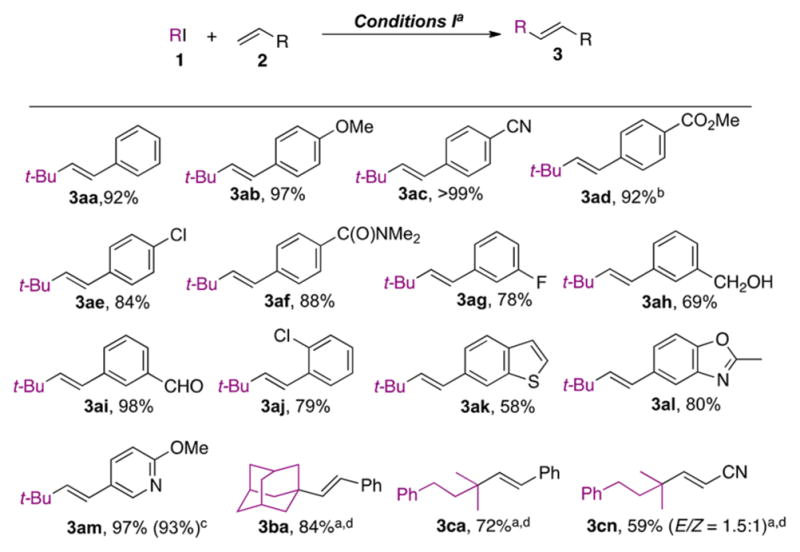
aConditions I: 1a 1.0 mmol, 2 0.5 mmol, Pd(OAc)2 0.05 mmol, Xantphos 0.1 mmol, Cs2CO3 1 mmol, PhH 0.5 M, 34 W blue LED, rt, 12 h. bPd(OAc)2 (2 mol %) and Xantphos (4 mol %) was added to the reaction mixture after 12 h, and the reaction was stirred for an additional 6 h. cYield for a 1 mmol scale reaction. d1 (0.25 mmol) and 2 (0.5 mmol) were used.
Next, the scope of activated tertiary alkyl halides under the newly developed thermal Heck reaction conditions was examined (Scheme 3). It was found that a variety of electron-deficient alkyl halides underwent smooth Heck reaction to produce electrophilic alkenes, possessing carbethoxydimethyl-(3da), phosphonyldimethyl- (3ea), tosyldimethyl- (3fa), and dicarbethoxymethyl- (3gb–gp) moieties in good to nearly quantitative yields. Motivated by the great synthetic usefulness of allylboronates,22,23 we attempted approaching this important motif via Heck reaction of pinacolboronyldimethyl methyl iodide (1h). Gratifyingly, it was found that a wide range of electronically different styrenes, as well as vinyl heteroarenes, underwent a smooth reaction with 1h, resulting in useful22 tertiary allylic boronates (3ha–hl) in excellent yields.
Scheme 3. Scope of Activated Tertiary Alkyl Halidesa,b.
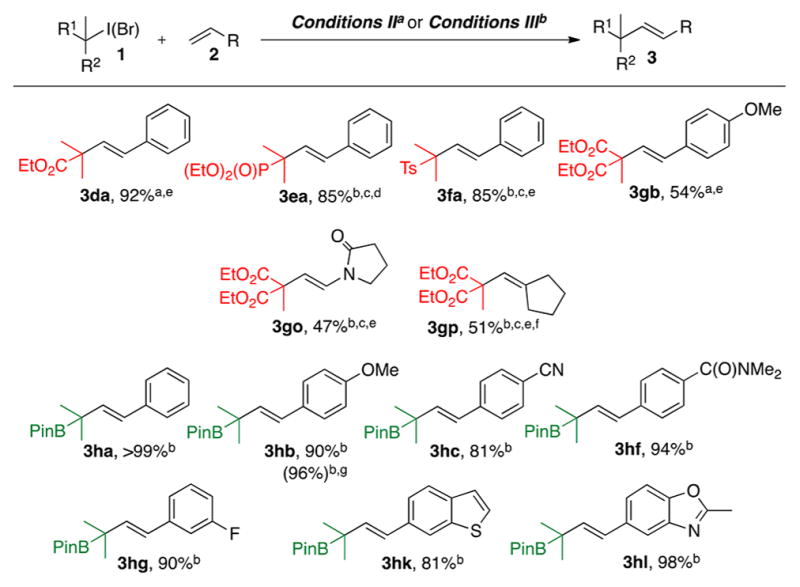
aConditions II: 1 (0.25 mmol), 2 (5 mmol), Pd(OAc)2 (0.025 mmol), Xantphos (0.05 mmol), Cs2CO3 (0.5 mmol), PhH (0.5 mL), rt, 12 h. bConditions III: 1a (0.375 mmol), 2 (0.25 mmol), Xantphos Pd G3 (0.025 mmol), iPr2NEt (0.5 mmol), PhH (0.5 mL), 40 °C, 12 h. c1 (0.25 mmol) and 2 (0.5 mmol) were used. d5 mol % of Xantphos Pd G3 was used. eAlkyl bromide was used. fReaction required 45 °C and 24 h for completion. gYield for a 1 mmol scale reaction.
Upon investigating the scope of this transformation, it was found that the reaction of tertiary alkyl bromide 1g with phenyl vinyl ether (2s) did not produce the expected Heck product. However, in the presence of O-nucleophiles, the carboxyalkoxylation and alkoxyalkylation adducts, mixed acetals 4a and 4b, were selectively obtained (Scheme 4). It is apparent that in contrast to the previously reported reactions involving aryl-(18b) and alkyl Pd-radical hybrid species,16,18,19 this transformation proceeds through cationic intermediates (vide infra).
Scheme 4.
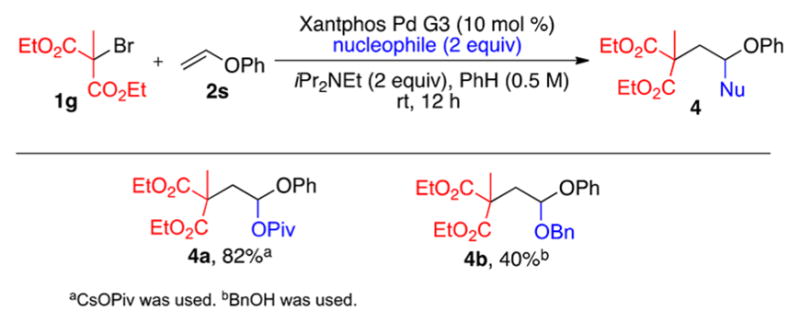
Carboxyloxy- and Alkoxyalkylation of Aryl Vinyl Ether
On the basis of the observations above (Scheme 4) and our initial mechanistic studies, including radical clock experiments, radical trapping, and Stern–Volmer quenching experiments,24 as well as literature precedents for Heck reactions of alkyl halides,8,16,19 the following hybrid-Pd radical mechanism is proposed for this transformation (Scheme 5). First, the in situ generated Pd(0) species undergoes visible-light excitation to produce the active Pd(0) complex A. Next, it undergoes an SET with alkyl halide 1 to produce the putative alkyl Pd–hybrid radical species B.25 Addition of the latter to alkene 2 produces a new alkyl radical intermediate C. A subsequent β-H-elimination delivers Heck product 3 and closes the catalytic cycle (D → A). Alternatively, in the reaction with electron-rich aryl vinyl ether (2s, Scheme 4), the Pd(I) species oxidizes intermediate C26 into the stabilized cation E, which is then trapped by a nucleophile to give the double-addition product, acetal 4.
Scheme 5.

Proposed Reaction Mechanism
In conclusion, we developed the first general, efficient, and mild Heck reaction of tertiary alkyl halides. This visible light-induced Pd-catalyzed method, which works well with unactivated tertiary alkyl halides, operates at room temperature and does not require employment of exogenous photosensitizers. For activated tertiary alkyl halides, the same catalytic system does not require light for a successful Heck coupling. Employment of an array of alkyl halides allows synthesis of valuable electronically diverse allylic products, including neutral alkenes possessing quaternary carbon centers, electron-deficient alkenes having carbalkoxy- and tosyl groups, as well as nucleophilic allylboronates. Importantly, for the reactions of electronically different alkenes, a mechanistic dichotomy was discovered. Thus, in contrast to the reactions with electron-neutral and electron-deficient alkenes, operating via hybrid Pd-radical mechanism, the reactions with electron-rich alkenes proceed through a hybrid radical/cationic pathway leading to mixed acetals, the products of the double-addition process.
Supplementary Material
Acknowledgments
We thank the National Institutes of Health (GM120281) for financial support of this work. We also thank Ms. Yana McAuliff (University of Illinois at Chicago) for technical help, Dr. Yang Wang (Northwestern University) for initial experiments, and Dr. Marvin Parasram (Princeton University) for helpful discussions.
Footnotes
Notes
The authors declare no competing financial interest.
The Supporting Information is available free of charge on the ACS Publications website at DOI: 10.1021/acs.orglett.7b03591.
Experimental details, characterization data for the products, and NMR spectra (PDF)
References
- 1.(a) Heck RF, Nolley JP. J Org Chem. 1972;37:2320. [Google Scholar]; (b) Mizoroki T, Mori K, Ozaki A. Bull Chem Soc Jpn. 1971;44:581. [Google Scholar]
- 2.Oestreich M. The Mizoroki–Heck Reaction. John Wiley & Sons; West Sussex, U.K: 2009. [Google Scholar]
- 3.Bräse S, deMeijere A. In: Metal-catalyzed Cross-Coupling Reactions. Diederich F, Stang PJ, editors. Chapter 3 Wiley-VCH; Weinheim: 1998. [Google Scholar]
- 4.Ariafard A, Lin Z. Organometallics. 2006;25:4030. [Google Scholar]
- 5.For examples of Pd-catalyzed Heck reactions of alkyl halides possessing carbon-based β-electron-withdrawing groups, see: Glorius F. Tetrahedron Lett. 2003;44:5751.Mori M, Oda I, Ban Y. Tetrahedron Lett. 1982;23:5315.
- 6.For examples of Heck reaction of perfluorinated alkyl halides, see: Feng Z, Min QQ, Zhao HY, Gu JW, Zhang X. Angew Chem, Int Ed. 2015;54:1270. doi: 10.1002/anie.201409617.Zhang F, Min QQ, Zhang X. Synthesis. 2015;47:2912.Surapanich N, Kuhakarn C, Pohmakotr M, Reutrakul V. Eur J Org Chem. 2012;2012:5943.Li Z, Merino E, Nevado C. Top Catal. 2017 doi:60.54510.1007/s11244-017-0743-y.Li Z, García-Domínguez A, Nevado C. J Am Chem Soc. 2015;137:11610. doi: 10.1021/jacs.5b07432.
- 7.Firmansjah L, Fu GC. J Am Chem Soc. 2007;129:11340. doi: 10.1021/ja075245r. [DOI] [PubMed] [Google Scholar]
- 8.Bloome KS, McMahen RL, Alexanian EJ. J Am Chem Soc. 2011;133:20146. doi: 10.1021/ja2091883.McMahon CM, Alexanian EJ. Angew Chem, Int Ed. 2014;53:5974. doi: 10.1002/anie.201311323.. See also: Zou YJ, Zhou JR. Chem Commun. 2014;50:3725. doi: 10.1039/c4cc00297k.. For a review on hybrid alkyl Pd-radical transformations, see: Liu Q, Dong X, Li J, Xiao J, Dong Y, Liu H. ACS Catal. 2015;5:6111.
- 9.Liu C, Tang S, Liu D, Yuan J, Zheng L, Meng L, Lei A. Angew Chem, Int Ed. 2012;51:3638. doi: 10.1002/anie.201108350. [DOI] [PubMed] [Google Scholar]
- 10.Zhu K, Dunne J, Shaver MP, Thomas SP. ACS Catal. 2017;7:2353. [Google Scholar]
- 11.Nishikata T, Noda Y, Fujimoto R, Sakashita T. J Am Chem Soc. 2013;135:16372. doi: 10.1021/ja409661n. [DOI] [PubMed] [Google Scholar]
- 12.(a) Ikeda Y, Nakamura T, Yorimitsu H, Oshima K. J Am Chem Soc. 2002;124:6514. doi: 10.1021/ja026296l. [DOI] [PubMed] [Google Scholar]; (b) Affo W, Ohmiya H, Fujioka T, Ikeda Y, Nakamura T, Yorimitsu H, Oshima K, Imamura Y, Mizuta T, Miyoshi K. J Am Chem Soc. 2006;128:8068. doi: 10.1021/ja061417t. [DOI] [PubMed] [Google Scholar]
- 13.Xie J, Li J, Weingand V, Rudolph M, Hashmi ASK. Chem - Eur J. 2016;22:12646. doi: 10.1002/chem.201602939.. For related visible light-induced couplings, see: Witzel S, Xie J, Rudolph M, Hashmi ASK. Adv Synth Catal. 2017;359:1522.Xie J, Rudolph M, Rominger F, Hashmi ASK. Angew Chem, Int Ed. 2017;56:7266. doi: 10.1002/anie.201700135.
- 14.Bräse S, Waegell B, deMeijere A. Synthesis. 1998;1998:148. [Google Scholar]
- 15.For reviews on photoredox catalysis, see: Prier CK, Rankic DA, MacMillan DWC. Chem Rev. 2013;113:5322. doi: 10.1021/cr300503r.Skubi KL, Blum TR, Yoon TP. Chem Rev. 2016;116:10035. doi: 10.1021/acs.chemrev.6b00018.Romero NA, Nicewicz DA. Chem Rev. 2016;116:10075. doi: 10.1021/acs.chemrev.6b00057.Staveness D, Bosque I, Stephenson CRJ. Acc Chem Res. 2016;49:2295. doi: 10.1021/acs.accounts.6b00270.Tellis JC, Kelly CB, Primer DN, Jouffroy M, Patel NR, Molander GA. Acc Chem Res. 2016;49:1429. doi: 10.1021/acs.accounts.6b00214.Meggers E. Chem Commun. 2015;51:3290. doi: 10.1039/c4cc09268f.Xie J, Jin H, Hashmi ASK. Chem Soc Rev. 2017;46:5193. doi: 10.1039/c7cs00339k.. For selected examples, see: Shu W, Nevado C. Angew Chem, Int Ed. 2017;56:1881. doi: 10.1002/anie.201609885.Shu W, Genoux A, Li Z, Nevado C. Angew Chem, Int Ed. 2017;56:10521. doi: 10.1002/anie.201704068.Hu XQ, Chen JR, Xiao WJ. Angew Chem, Int Ed. 2017;56:1960. doi: 10.1002/anie.201611463.Gutierrez O, Tellis JC, Primer DN, Molander GA, Kozlowski MC. J Am Chem Soc. 2015;137:4896. doi: 10.1021/ja513079r.Zhang J, Li Y, Zhang F, Hu C, Chen Y. Angew Chem, Int Ed. 2016;55:1872. doi: 10.1002/anie.201510014.Wang C, Harms K, Meggers E. Angew Chem, Int Ed. 2016;55:13495. doi: 10.1002/anie.201607305.Chu JCK, Rovis T. Nature. 2016;539:272. doi: 10.1038/nature19810.Choi GJ, Zhu Q, Miller DC, Gu CJ, Knowles RR. Nature. 2016;539:268. doi: 10.1038/nature19811.
- 16.Kurandina D, Parasram M, Gevorgyan V. Angew Chem, Int Ed. 2017;56:14212. doi: 10.1002/anie.201706554. [DOI] [PMC free article] [PubMed] [Google Scholar]
- 17.For selected examples of Pd-catalyzed transformations employing exogenous photosensitizers, see: Kalyani D, McMurtrey KB, Neufeldt SR, Sanford MS. J Am Chem Soc. 2011;133:18566. doi: 10.1021/ja208068w.Neufeldt SR, Sanford MS. Adv Synth Catal. 2012;354:3517. doi: 10.1002/adsc.201200738.Zhou C, Li P, Zhu X, Wang L. Org Lett. 2015;17:6198. doi: 10.1021/acs.orglett.5b03192.Choi S, Chatterjee T, Choi WJ, You Y, Cho E. ACS Catal. 2015;5:4796.Liu K, Zou M, Lei A. J Org Chem. 2016;81:7088. doi: 10.1021/acs.joc.6b00965.Zhang H, Huang X. Adv Synth Catal. 2016;358:3736.Kärkäs MD, Bosque I, Matsuura BS, Stephenson CR. Org Lett. 2016;18:5166. doi: 10.1021/acs.orglett.6b02651.
- 18.For a review on visible light-induced transition metal-catalyzed transformations without exogenous photosensitizers, see: Parasram M, Gevorgyan V. Chem Soc Rev. 2017;46:6227. doi: 10.1039/c7cs00226b.See also: Parasram M, Chuentragool P, Sarkar D, Gevorgyan V. J Am Chem Soc. 2016;138:6340. doi: 10.1021/jacs.6b01628.Parasram M, Chuentragool P, Wang Y, Shi Y, Gevorgyan V. J Am Chem Soc. 2017;139:14857. doi: 10.1021/jacs.7b08459.
- 19.When this manuscript was in preparation, two independent reports describing a direct generation of tertiary Pd hybrid radical species from unactivated alkyl halides and Pd catalyst upon visible light irradiation appeared. For employment of tertiary halides in C–H functionalizations, see: Zhou WJ, Cao GM, Shen G, Zhu XY, Gui YY, Ye JH, Sun L, Liao LL, Li J, Yu DG. Angew Chem, Int Ed. 2017;56:15683. doi: 10.1002/anie.201704513.. For employment of tertiary halides in Heck reaction, see: Wang GZ, Shang R, Cheng WM, Fu Y. J Am Chem Soc. 2017;139:18307. doi: 10.1021/jacs.7b10009.
- 20.Monks BM, Cook SP. Angew Chem, Int Ed. 2013;52:14214. doi: 10.1002/anie.201308534. [DOI] [PubMed] [Google Scholar]
- 21.Attempts on employment of electron-neutral aliphatic alkenes, as well as electron-rich vinyl ethers, in the Heck reaction with unactivated alkyl halides were unsuccessful.
- 22.For selected examples on synthetic usefulness of tertiary boronic esters, see: Odachowski M, Bonet A, Essafi S, Conti-Ramsden P, Harvey JN, Leonori D, Aggarwal VK. J Am Chem Soc. 2016;138:9521. doi: 10.1021/jacs.6b03963.Ardolino MJ, Morken JP. J Am Chem Soc. 2014;136:7092. doi: 10.1021/ja502280w.Scott HK, Aggarwal VK. Chem - Eur J. 2011;17:13124. doi: 10.1002/chem.201102581.. For a review, see: Diner C, Szabo KJ. J Am Chem Soc. 2017;139:2. doi: 10.1021/jacs.6b10017.
- 23.For selected examples on synthetic methods toward tertiary boronic esters, see: Bose SK, Fucke K, Liu L, Steel PG, Marder TB. Angew Chem, Int Ed. 2014;53:1799. doi: 10.1002/anie.201308855.Ondrusek BA, Park JK, McQuade T. Synlett. 2014;25:239.Chakrabarty S, Takacs JM. J Am Chem Soc. 2017;139:6066. doi: 10.1021/jacs.7b02324.Pulis AP, Aggarwal VK. J Am Chem Soc. 2012;134:7570. doi: 10.1021/ja303022d.Hu N, Zhao G, Zhang Y, Liu X, Li G, Tang W. J Am Chem Soc. 2015;137:6746. doi: 10.1021/jacs.5b03760.
- 24.See the Supporting Information for details.
- 25.For activated alkyl halides, the homolysis of the C–X bond in the presence of a Pd/phosphine ligand catalytic system may occur under mild thermal conditions. See ref 8d.
- 26.For examples of thermal radical/oxidative reactions, see: Liu YY, Yang XH, Song RJ, Luo S, Li JH. Nat Commun. 2017;8:14720. doi: 10.1038/ncomms14720.Gockel SN, Buchanan TL, Hull KL. J Am Chem Soc. 2017 doi: 10.1021/jacs.7b10529., For examples of photoinduced radical/oxidative reactions, see:. Nguyen JD, Tucker JW, Konieczynska MD, Stephenson CRJ. J Am Chem Soc. 2011;133:4160. doi: 10.1021/ja108560e.Wallentin CJ, Nguyen JD, Finkbeiner P, Stephenson CRJ. J Am Chem Soc. 2012;134:8875. doi: 10.1021/ja300798k.Hollister KA, Conner ES, Spell ML, Deveaux K, Maneval L, Beal MW, Ragains JR. Angew Chem, Int Ed. 2015;54:7837. doi: 10.1002/anie.201500880.
Associated Data
This section collects any data citations, data availability statements, or supplementary materials included in this article.


